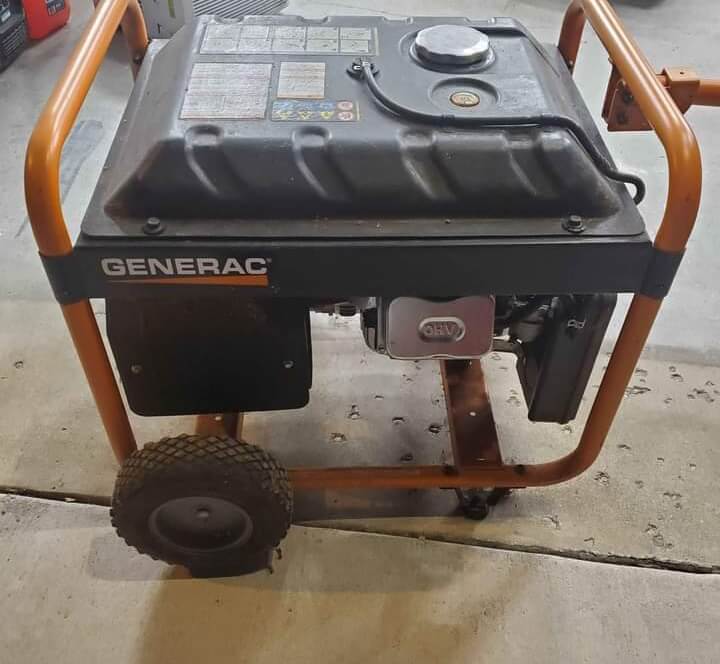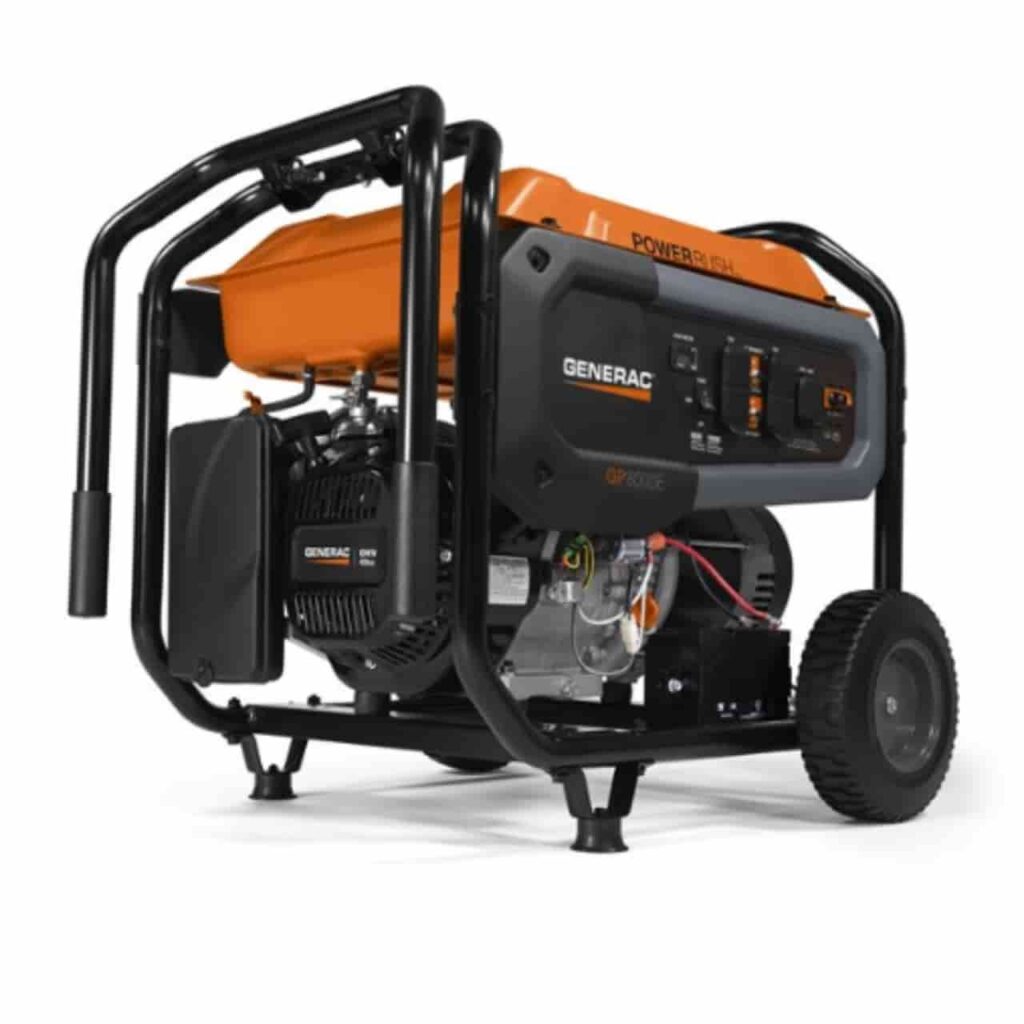As an Amazon Associate, we earn from qualifying purchases. This does not affect the price you pay or the quality of the products you buy. For more information, please read the full affiliate disclosure here.
Have you ever experienced your generator sputtering when you needed it the most? You can tell if your generator is sputtering by listening to the sound and observing the performance of the generator. If your generator is sputtering, you may hear popping, coughing, or spitting noises from the engine. You may also notice that the generator is running rough, losing power, or stalling.
A sputtering generator can be dangerous for several reasons:
- It can damage your generator or the appliances connected to it, as it can cause fluctuations, surges, or drops in voltage and frequency. This can harm your sensitive electronics or devices, such as laptops, TVs, or phones.
- It can cause the engine to overheat, smoke, or leak fuel. This can increase the risk of fire, explosion, or carbon monoxide poisoning.
- It can reduce the efficiency and the lifespan of your generator, as it can cause wear and tear, corrosion, or carbon buildup in the engine and the fuel system.
Therefore, it is important to know why your generator is sputtering and how to fix it.
However, fixing a sputtering generator is not as easy as it sounds. You need to identify the root cause of the problem and apply the appropriate solution.
In addition, you need to prevent your generator from sputtering again in the future. You need to follow some maintenance tips and best practices to keep your generator in good condition.
In this blog post, we will explain the common causes of generator sputtering, the steps to fix it, and the tips to prevent it. By the end of this post, you will be able to solve the sputtering issue and enjoy the benefits of your generator.
What causes a generator to sputter?

Generator sputtering can be caused by a variety of issues. Common causes of generator sputtering include:
1. Faulty or clogged carburetor
The carburetor is the part that mixes air and fuel for combustion. If the carburetor is faulty or clogged, it will not provide the proper air-to-fuel ratio for the engine, resulting in sputtering or rough running. This can happen due to stale or low-quality fuel, dirt, or debris in the fuel system. A faulty or clogged carburetor can also cause the engine to overheat, smoke, or leak fuel.
2. Clogged or broken fuel lines
The fuel lines are the hoses that deliver fuel from the tank to the carburetor. If the fuel lines are clogged or broken, they will restrict the fuel flow and cause the engine to starve for fuel. This can happen due to corrosion, wear and tear, or contamination in the fuel system. A clogged or broken fuel line can also cause the engine to leak fuel, lose pressure, or burst.
3. Dirty or clogged fuel filter
The fuel filter is the part that filters out any impurities or particles from the fuel before it reaches the carburetor. If the fuel filter is dirty or clogged, it will reduce the fuel pressure and volume and cause the engine to sputter or stall. This can happen due to poor fuel quality, sediment, or water in the fuel system. A dirty or clogged fuel filter can also cause the engine to run lean, overheat, or knock.
4. Clogged air filter
The air filter is the part that filters out any dust or debris from the air before it enters the carburetor. If the air filter is clogged, it will reduce the air intake and cause the engine to run rich or lean, resulting in sputtering or backfiring. This can happen due to dusty or dirty environments or a lack of maintenance. A clogged air filter can also cause the engine to lose power, overheat, or emit black smoke.
5. Faulty spark plug
The spark plug is the part that ignites the air-fuel mixture in the combustion chamber. If the spark plug is faulty, it will not produce a strong or consistent spark and cause the engine to misfire or sputter. This can happen due to carbon buildup, corrosion, or damage to the spark plug or its wire. A faulty spark plug can also cause the engine to run rough, lose power, or emit white smoke.
6. Overloading
Overloading is the situation when the generator is supplying more power than it can produce. This can cause the engine to struggle and sputter, as well as damage the generator or the appliances connected to it. This can happen due to improper sizing, faulty wiring, or excessive demand. Overloading can also cause the generator to overheat, trip, or shut down.
How to Fix a Sputtering Generator
Depending on the cause of the sputtering, there are different ways to fix it. Here are some general steps you can follow to troubleshoot and fix a sputtering generator:
1. Check the fuel level and quality.
Make sure your generator has enough fuel in the tank and that the fuel is fresh and clean. If the fuel is old, stale, or contaminated, drain it and replace it with new fuel. You can also add a fuel stabilizer or a fuel cleaner to prevent or remove any deposits in the fuel system. To check the fuel quality, you can use a fuel tester or a fuel analyzer. These are devices that can measure the octane, ethanol, water, or sediment content of the fuel. You can also look for any signs of discoloration, cloudiness, or separation in the fuel.
2. Check the fuel lines and filter.
Inspect the fuel lines and filter for any cracks, leaks, or clogs. If the fuel lines are damaged or clogged, replace them with new ones. If the fuel filter is dirty or clogged, clean it or replace it with a new one. To check the fuel lines and filter, you can use a fuel pressure gauge or a fuel flow meter. These are devices that can measure the pressure and volume of the fuel in the fuel system. You can also look for any signs of kinks, bends, or cuts in the fuel lines, or any dirt, rust, or water in the fuel filter.
If you aren’t sure how to clean up your generators fuel line and filter, here’s a complete guide we previously written on How to Clean Generator Fuel Filter in 8 Simple Ways .
3. Check the carburetor.
Inspect the carburetor for any dirt, debris, or gumming. If the carburetor is dirty or clogged, clean it with a carburetor cleaner or a brush. You may also need to adjust the carburetor settings to ensure the proper air-fuel ratio. If the carburetor is faulty or damaged, repair it or replace it with a new one. To check the carburetor, you can use a vacuum gauge or a manometer. These are devices that can measure the vacuum or pressure in the intake manifold. You can also look for any signs of leaks, cracks, or corrosion in the carburetor, or any black, white, or blue smoke from the exhaust.
Recommended Read:- How to Stop Fuel Leaking from Carburetor in 8 Steps + Video
4. Check the air filter.
Inspect the air filter for any dust, dirt, or clogs. If the air filter is dirty or clogged, clean it with compressed air or a brush. You may also need to replace the air filter if it is worn out or damaged. To check the air filter, you can use a light source or a magnifying glass. These are devices that can help you see any holes, tears, or stains in the air filter. You can also look for any signs of dust, dirt, or debris in the air intake or the carburetor.
If you’re confused about how to comfortably clean your generator air filter yourself, you can check out our exclusive guide on How to Clean Generator Air Filter in 8 Simple Ways + Video.
5. Check the spark plug.
Inspect the spark plug for any carbon buildup, corrosion, or damage. If the spark plug is dirty or fouled, clean it with a spark plug cleaner or a wire brush. You may also need to adjust the spark plug gap or replace the spark plug if it is worn out or damaged. To check the spark plug, you can use a spark tester or a multimeter. These are devices that can help you test the spark and the resistance of the spark plug. You can also look for any signs of cracks, burns, or erosion in the spark plug or its wire.
Recommended Read:- How to Fix a Generator Spark Plug: 5 Top Ways
6. Check the load.
Make sure your generator is not overloaded by checking the power rating and the wattage of the appliances connected to it. If the generator is overloaded, reduce the load by unplugging some appliances or using a larger generator. You can also use a wattmeter or a voltmeter to monitor the power output and the voltage of the generator. You can also look for any signs of overheating, tripping, or shutting down the generator or the appliances.
How do I prevent a generator from sputtering?

The best way to prevent a generator from sputtering is to maintain it regularly and properly. Here are some tips on how to keep your generator in good condition and avoid sputtering.
1. Use high-quality fuel.
Always use fresh and clean fuel that meets the specifications of your generator. Avoid using ethanol-blended fuel, as it can cause corrosion and gumming in the fuel system. You can also use a fuel stabilizer or a fuel cleaner to extend the shelf life and improve the performance of the fuel. You should also store the fuel in a cool, dry, and well-ventilated place, away from any heat or ignition sources. You should also use a fuel container that is compatible with your fuel type and has a tight seal.
2. Drain the fuel tank and carburetor.
If you are not going to use your generator for a long time, drain the fuel tank and the carburetor to prevent the fuel from going stale or evaporating. You can also run the generator until it runs out of fuel to empty the fuel system. This will help prevent any deposits or varnish from forming in the fuel system and causing clogs or leaks. You should also turn off the fuel valve and disconnect the fuel line from the carburetor when storing the generator.
Recommended Read:- Can You Dump Old Gas on the Ground?
3. Change the oil and filter.
Change the oil and the oil filter regularly according to the manufacturer’s recommendations. Use the correct type and amount of oil for your generator. Check the oil level and quality before each use, and top it up if needed. You should also use a high-quality oil that is suitable for your generator’s engine type and climate conditions. You should also store the oil in a cool, dry, and well-ventilated place, away from any heat or ignition sources. You should also use an oil container that has a tight seal and a spout for easy pouring.
4. Clean the air filter.
Clean the air filter regularly according to the manufacturer’s recommendations. Use compressed air or a brush to remove any dust or dirt from the air filter. You may also need to replace the air filter if it is worn out or damaged. To check the air filter, you can use a light source or a magnifying glass. These are devices that can help you see any holes, tears, or stains in the air filter. You can also look for any signs of dust, dirt, or debris in the air intake or the carburetor. A clean air filter will help your generator breathe better and run more efficiently.
5. Inspect the spark plug.
Inspect the spark plug regularly according to the manufacturer’s recommendations. Use a spark plug cleaner or a wire brush to remove any carbon buildup or corrosion from the spark plug. You may also need to adjust the spark plug gap or replace the spark plug if it is worn out or damaged. To check the spark plug, you can use a spark tester or a multimeter. These are devices that can help you test the spark and the resistance of the spark plug. You can also look for any signs of cracks, burns, or erosion in the spark plug or its wire. A good spark plug will help your generator ignite the fuel properly and run smoothly.
6. Store the generator properly.
Store the generator in a cool, dry, and well-ventilated place. Cover the generator with a protective cover to prevent dust, moisture, or insects from entering the generator. Avoid storing the generator near any flammable or corrosive materials. You should also disconnect the battery and remove the spark plug when storing the generator. This will help prevent any corrosion, leakage, or short circuit in the generator.
For further reading read; How to Store a Generator: Best Practices for Long-Term Storage
The Final Words
Generator sputtering is a common problem that can affect the performance and lifespan of your generator. By following the steps and tips in this blog post, you can troubleshoot and fix the sputtering issue and prevent it from happening again. Remember to always read the owner’s manual and follow the safety precautions when using and maintaining your generator. If you are not confident or experienced in fixing the generator yourself, you can always contact a professional service technician for help. We hope this blog post has been helpful and informative for you. If you have any questions or comments, please feel free to leave them below.
Share


